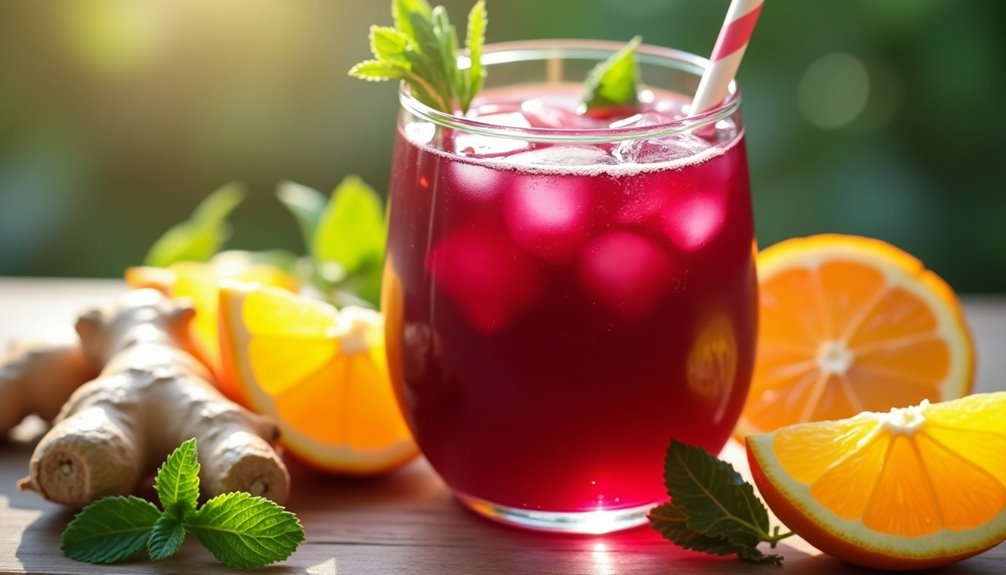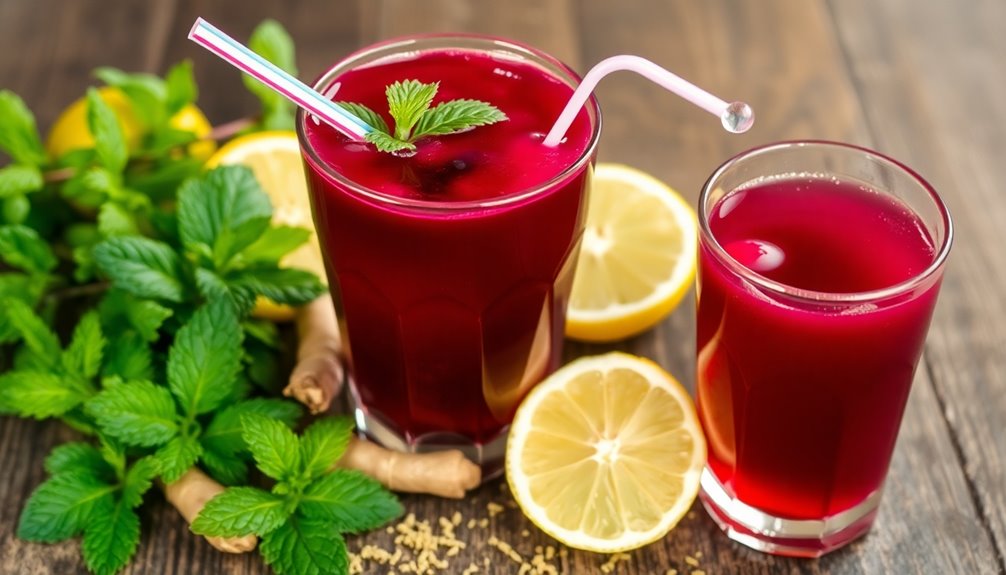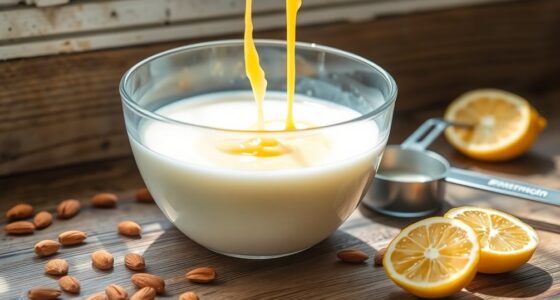To make beet juice taste better, start by choosing milder varieties like baby or golden beets. Balance the flavors by keeping fruit content between 25-40% and adding fresh non-starchy veggies like cucumber. Mixing in apples, citrus, or a splash of lemon brightens the juice, while fresh ginger adds a zesty kick. For the best flavor, enjoy it fresh or chilled, and don’t hesitate to experiment with different ingredients to find your perfect blend. You’ll discover even more tips ahead! You can also enhance the beet juice flavor profile by incorporating herbs like mint or basil, which provide an aromatic freshness. A touch of honey or agave syrup can add sweetness without overpowering the earthy notes of the beets. When creating your custom blends, consider trying spices such as turmeric or cinnamon to give your juice a unique twist and additional health benefits.
Key Takeaways
- Choose milder beet varieties like baby or golden beets for a sweeter, less earthy flavor.
- Maintain a fruit ratio of 25-40%, using apples or citrus to enhance sweetness and brightness.
- Add fresh ginger or mint to introduce zesty notes and cut through the heaviness of beets.
- Consume beet juice fresh or chilled within eight hours to retain optimal flavor and nutrients.
- Experiment with different ingredients and ratios to discover your preferred flavor blend.

If you've ever tried beet juice and found it a bit too earthy for your taste, you're not alone. Beet juice can be an acquired taste, but with a few tweaks, you can make it more enjoyable. One great way to enhance the flavor is by experimenting with different beet juice recipes. Start by choosing milder varieties, like baby or golden beets. These tend to have a sweeter, less intense flavor that can help balance out the earthy notes of raw beets. Roasting them before juicing can also enhance sweetness and reduce bitterness, giving you a smoother base for your juice.
When crafting your beet juice, consider the vegetable-to-fruit ratio. Keeping the fruit content between 25-40% can help maintain that characteristic earthy flavor while still introducing some sweetness. To achieve this balance, you might want to add non-starchy vegetables like spinach or cucumber. These ingredients not only add nutrients but also contribute to the overall freshness of your drink. The water content in cucumbers, for example, can lighten the texture, making your juice more refreshing.
To elevate the taste further, you should incorporate complementary flavors. Apples, citrus fruits like oranges or grapefruits, and fresh ginger are excellent choices. They add a zesty kick that offsets the earthiness of the beets and introduces a layer of complexity to the juice. Lemon juice is particularly effective; just a splash can brighten the entire drink. If you want to take it up another notch, try adding a few mint leaves or even a pinch of salt. These ingredients can cut through the heaviness and make your juice taste better.
Another key factor in enjoying beet juice is freshness. It's best to consume beet juice fresh or chilled, ideally within eight hours of preparation. This ensures that you not only get the vibrant flavor but also the maximum nutritional benefits. If you store it for too long, the taste and nutrients may degrade, leaving you with a less appealing product. So, when you make your beet juice, try to prepare just enough for your immediate enjoyment.
Lastly, don't hesitate to experiment with your beet juice recipes. You might find that a touch of fresh ginger adds just the right amount of zing, or that a different fruit perfectly complements the earthy flavor. Remember, the goal is to create a juice that you love, so feel free to adjust the ingredients until you find that perfect blend. With a bit of creativity and the right ingredients, beet juice can be a delicious and nutritious addition to your diet.
Frequently Asked Questions
How Do You Hide the Taste of Beet Juice?
To hide the taste of beet juice, you can mix in fruits like apples or citrus to balance the earthiness.
Adding ginger or lemon juice cuts through the dense flavor, making it more enjoyable.
Incorporate sweet vegetables like carrots or refreshing cucumbers to enhance the taste.
You might also try fresh herbs like mint for a pleasant aroma.
Finally, diluting the juice with water or ice can mellow its intensity without losing nutritional value.
What Makes Beetroot Juice Taste Better?
Picture a vibrant glass of deep crimson juice, glistening in the sunlight.
To make beetroot juice taste better, you'll want to blend in milder veggies like cucumber or spinach. Add a splash of zesty lemon juice or a hint of fresh ginger for a refreshing kick.
Chill it over ice, and consider a touch of honey for sweetness. This balance transforms the earthy tones into a delicious, invigorating drink that you'll savor.
What Is the Best Way to Consume Beet Juice?
To get the most out of beet juice, drink it right after you make it.
It's best enjoyed fresh for optimal flavor and health benefits.
If you want a refreshing twist, chill it in the fridge for a couple of hours or serve it over ice.
You can also dilute it with filtered water to make it lighter.
Just aim to consume it within eight hours to maintain its vibrant taste and nutrients.
How to Make Beetroot Taste Better?
Making beetroot taste better is like transforming a plain canvas into a vibrant masterpiece.
You can start by selecting milder beet varieties, such as baby or golden beets. Mixing in fresh veggies like spinach or cucumber helps balance the earthy flavor.
Try adding ginger, lemon juice, or mint for a refreshing twist. Chilling the beetroot before serving enhances its appeal, and if you want sweetness, a touch of honey or maple syrup works wonders!
Conclusion
By mixing in fruits like apples or citrus, you transform beet juice from a solitary root into a vibrant garden of flavors. Just as a rainbow emerges after a storm, your beet juice can burst with life and excitement. Experimenting with spices, herbs, or even a hint of honey allows you to craft a unique blend that speaks to your palate. Embrace this journey, and let your creativity bloom, turning every sip into a refreshing celebration of taste.
Cindy thoroughly researches juicing trends, techniques, and recipes to provide readers with practical advice and inspiration. Her writing style is accessible, engaging, and designed to make complex concepts easy to understand. Cindy’s dedication to promoting the advantages of juicing shines through her work, empowering readers to make positive changes in their lives through the simple act of juicing.











